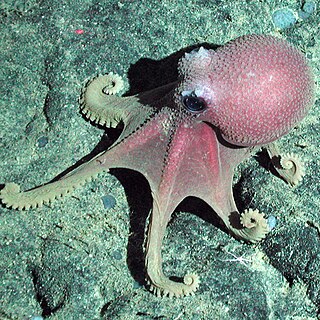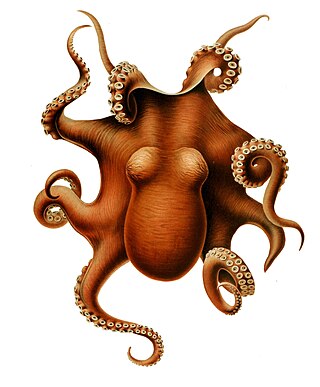
Cirroteuthidae is a family of pelagic cirrate octopuses comprising at least three species in two genera.

Grimpoteuthis is a genus of pelagic cirrate (finned) octopods known as the dumbo octopuses. The name "dumbo" originates from their resemblance to the title character of Disney's 1941 film Dumbo, having two prominent ear-like fins which extend from the mantle above each eye. There are 17 species recognized in the genus. Prey include crustaceans, bivalves, worms and copepods. The average life span of various Grimpoteuthis species is 3 to 5 years.

Umbrella octopuses are a group of pelagic octopuses. Umbrella octopuses are characterized by a web of skin between the arms, causing them to somewhat resemble an opened umbrella when the arms are spread.

Cirrina or Cirrata is a suborder and one of the two main divisions of octopuses. Cirrate octopuses have a small, internal shell and two fins on their head, while their sister suborder Incirrina has neither. The fins of cirrate octopods are associated with a unique cartilage-like shell in a shell sac. In cross-section, the fins have distinct proximal and distal regions, both of which are covered by a thin surface sheath of muscle.

Enteroctopus is an octopus genus whose members are sometimes known as giant octopuses.

Octopus is the largest genus of octopuses, comprising more than 100 species. These species are widespread throughout the world's oceans. Many species formerly placed in the genus Octopus are now assigned to other genera within the family. The octopus has 8 arms, averaging 20 cm (8 in) long for an adult.

Adelieledone is a genus of octopuses in the family Megaleledonidae.

Pareledone is a genus of octopuses in the family Megaleledonidae.

Graneledone is a genus of octopuses in the family Octopodidae. The type species is Eledone verrucosaVerrill, 1881.
Thaumeledone is a genus of octopuses in the family Octopodidae found in deep waters in the Southern Hemisphere.

Enteroctopus megalocyathus, also known as Patagonian red octopus (EN), Pulpo del sur (Chile) and Pulpo colorado (Argentina); is a medium-sized octopus, and the type species for the genus Enteroctopus.

Muusoctopus levis is a species of octopus in the family Enteroctopodidae. It was first described by William Evans Hoyle in 1885 in an article in the Annals and Magazine of Natural History detailing the new species of octopus found on HMS Challenger as part of the Challenger expedition; the type specimen was retrieved from the Southern Ocean. The species is found in subantarctic waters in the Southern Ocean, particularly surrounding Heard Island and Kerguelen Island, but specimens comparable to M. levis have also been found at the Antarctic Peninsula.
Graneledone yamana is a species of octopus in the genus Graneledone.

Callistoctopus is a genus of nocturnal, orange octopuses in the family Octopodidae. They are readily identifiable by their reddish coloring, the white papillae that line their bodies, and their long arms. Though sympatric with diurnal Octopus species, they avoid competition by hunting at night. In acknowledgement of this preference, many species of Callistoctopus are referred to as night octopuses. Well-known species include C. macropus and the type species C. ornatus, both of which are harvested for human consumption as seafood.

Grimpoteuthis bathynectes is a deepwater species of Grimpoteuthis (Dumbo) octopus first described in 1990. It is known from 13 specimens.

Louise Allcock is a British researcher, best known for her work on ecology and evolution of the cephalopods of the Southern Ocean and deep sea. She is the editor of the Zoological Journal of the Linnean Society.

Megaleledonidae is a family of octopuses in the superfamily Octopodoidea. It was formerly placed in the family Octopodidae sensu lato as the subfamily Megaleledoninae but more recent studies have raised this taxon as a valid family.
Opisthoteuths hardyi is a lesser-known octopus species. It was described in 2002 from a male caught off the Shag Rocks, which are far south in the Atlantic Ocean near the Falkland Islands.

Octopus vitiensis, or the bighead octopus, is a species of octopus provisionally placed in the genus Octopus. It was described by William Evans Hoyle in 1885 based on a specimen found in reefs in Kandavu, Fiji during a voyage of HMS Challenger.

Grimpoteuthidae are a family of bentho-pelagic octopuses, comprising three currently accepted genera. They have extensive arm webbing and relatively large fins allowing for powerful fin swimming.

















